I participated in the Virginia Youth Conservation Leadership Institute by leading a project to measure the impact of Leave No Trace education at Great Falls Parks in Virginia on trash in the park. I took the Leave No Trace Trainer course and attended stream monitoring sessions. From 04/2022 to 06/2022 I led scouts in my Troop 55 to educate 273 park visitors and collect 476.1 pounds of trash.
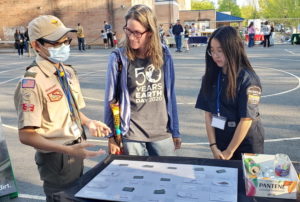 Great Falls National Park (VA) has been a popular tourist destination even before COVID-19 for its rich history – home to one of the nation’s first canals, the scenic view of the Great Falls of the Potomac, as well as hiking trails along Potomac River. After the COVID-19 lockdown in 2020 and the local government’s encouragement of the using of parks and outdoor recreation to mitigate mental health issues, Great Falls National Park again became a hot destination for families in the Washington DC area.
Great Falls National Park (VA) has been a popular tourist destination even before COVID-19 for its rich history – home to one of the nation’s first canals, the scenic view of the Great Falls of the Potomac, as well as hiking trails along Potomac River. After the COVID-19 lockdown in 2020 and the local government’s encouragement of the using of parks and outdoor recreation to mitigate mental health issues, Great Falls National Park again became a hot destination for families in the Washington DC area.
The park has a nice and well-maintained picnic area near the visitor center, with access to restrooms and a concession window. Though the park provides multiple waste bins around the picnic area, many visitors leave trash on the ground. Moreover, the park had a two parking lots near the visitor center in which both have trash problems. Great Falls National Park Volunteer and Youth Program Coordinator, Ms. Trudy Roth, has worked with our local Scouts BSA Troop 55( Boy) and Troop 55G(Girl) to have scouts and adult volunteers pick up litter at the picnic area and parking lots. Pickups had been conducted every two weeks, between the month of April and November since 2020, when the weather was warm and when the park attracted the most visitors.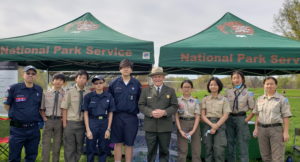
When I participated in the litter pick up service project with BSA Troop 55 scouts every other week, I noticed that roughly the same amount of trash needed to be picked up after our bi-weekly effort. At our Boy Scout Troop monthly outings, we have always practiced “Leave No Trace” (LNT) principles after we left a camp site or activity area. So, I wondered if the “Leave No Trace” education that was emphasized to every scout to keep parks clear of trash after every camping would make a difference to the public. If so, to what degree would it reduce the litter issue at the park? With those questions, in the October of 2021, I applied for the “Youth Conservation Leadership Institute” program (https://vaswcd.org/ycli), a youth leadership program sponsored by the Virginia Soil & Water Conservation Districts.
To prepare for my project, I first completed the “Leave No Trace Trainer” course in the October of 2021. I also reached out to Dr. Sara Holtz, a conservation champion in National Capital Area Council of Scouts BSA, and asked her to be my mentor to help me with my project proposal and resource planning. In October 2021 and February 2021, I participated in two sessions of “Stream Monitoring” projects with Northern Virginia Water & Soil Conservation District to understand the impact of litter on local water quality. In addition, I searched for research papers on the topic of the “Leave No Trace education’s impact” to help me understand the status of current research. I also attended a virtual Northern Virginia Soil & Water Conservation District board meeting in March 2022 to understand the government’s function for community conservation effort.
In the March of 2022, I began my work with the leadership teams from BSA Troop 55 to plan out the bi-weekly litter pickup project, also communicating my intention to conduct LNT education at Great Falls National Park. With the good relationship between Great Falls National Park (VA) and BSA Troop 55, I hoped that I could gain the approval from the National Park Community Service and Youth Coordinator Ms. Roth Trudy and Park Ranger Ms. Franice Sewell to conduct my LNT education sessions at the park. While waiting for project approval, I designed two LNT board games to educate park visitors on trash’s impact on the environment.
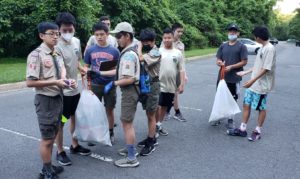 To allow for a comparison, I also participated and collected trash weight data from three sessions (March 20th, March 27th and April 10th) of the litter pick up project that BSA Troop 55 scouts completed at Great Falls National Park (VA). The trash weight data allowed me to establish the baseline data for my “pre-LNT” education sessions. The first step is to collect three rounds of trash, calculate the weight of the trash. Then, set up a “Leave No Trace” education/exhibition table at the picnic areas later at the park and educate visitors on the “Leave No Trace” principals for 2-3 hours. After the exhibition, the Troop 55 scouts collected trash again to see any difference in terms of weight of the trash to analyze the impact of “Leave No Trace”. My plan was to conduct 2-3 “Leave No Trace” education sessions at the picnic area to collect enough comparison data.
To allow for a comparison, I also participated and collected trash weight data from three sessions (March 20th, March 27th and April 10th) of the litter pick up project that BSA Troop 55 scouts completed at Great Falls National Park (VA). The trash weight data allowed me to establish the baseline data for my “pre-LNT” education sessions. The first step is to collect three rounds of trash, calculate the weight of the trash. Then, set up a “Leave No Trace” education/exhibition table at the picnic areas later at the park and educate visitors on the “Leave No Trace” principals for 2-3 hours. After the exhibition, the Troop 55 scouts collected trash again to see any difference in terms of weight of the trash to analyze the impact of “Leave No Trace”. My plan was to conduct 2-3 “Leave No Trace” education sessions at the picnic area to collect enough comparison data.
On April 16th, 2022, with the invitation from George Washington Memorial Parkway Community Service and Youth Coordinator Ms. Trudy, I was invited to conduct my pilot “Leave No Trace” education table at the Mount Vernon Trail 50th Year Celebration event at the Daingerfield Island National Park (Alexandria, VA). I recruited 10 volunteers and worked onsite for six hours, and we brought in more than 223 visitors for the “Leave No Trace” table and more than half of them played the board games that I designed. To promote the Sea Scouts program, I wore my Sea Scouts uniform, and had another two scouts wear them as well. George Washington Parkway’s Superintendent Mr. Charles Cuvelier visited the LNT booth and was excited to see the educational materials and the game design, and I also received great feedback from park ranger Aurelia Gracia for our efforts at the event.
With the success of the pilot program at the Mount Vernon Trail 50th Year Celebration event, and further communication and clarification on some questions from the park, I finally received the approval of my plan from the Great Falls National Park on the “Leave No Trace” education sessions. I had my first two-hour “Leave No Trace” education table at the park on April 24th, and I recruited ten scout volunteers and had 60 visitors for my first session. After the LNT session, I also worked with additional BSA Troop 55 scouts, and we collected 249 pounds of trash from the picnic area and parking lots. Between April 16th and June 5th 2022, I led more than 44 scouts and scouters, and the “Leave No Trace” sessions reached more than 555 visitors (with 272 from Great Falls National Park at Virginia). Between March 20th and June 5th, 2022, BSA Troop 55 collected 476.1 pounds of trash from the picnic area and parking lots of the park.
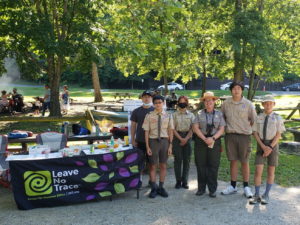 What I learned from the research on the Leave No Trace education:
What I learned from the research on the Leave No Trace education:
• Many visitors were surprised with how long certain items took to decompose such as fruits, soda cans, glass, and Styrofoam
• LNT will make a long-term impact for visitor behavior, many visitors’ feedback confirm this
• Short term LNT education sessions will not result in immediate reduction of litter at the park
• Park trash, in short term, will still be correlated to weather, temperature and picnic activities
• Long term LNT education is needed in conjunction with the troop’s litter pick up efforts.
In addition, I’ve developed my leadership, and took away team management and communication lessons from this project:
• Building a good relationship early – Troop 55 started work with Great Falls National Park since 2018 as a unit, not to mention many Eagle Scout projects were executed at the park
• Timely communication with park rangers and community service coordinator: design and plan, report the results of each session, address concerns and share activity photos
• Recruit volunteers: working with the home unit, Troop 55, to gather enough volunteers to help and support from troop leadership
• Work closely with a project mentor: communicate on materials needs, update on plan changes, invite mentor to come to your project site, report progress and result numbers
• Communicate with the YCLI project coordinator and stakeholder to make sure the project was on the right track and receive additional support.
By working with many scout volunteers, I’ve also learned these valuable tips for my future Eagle Scout project or Sea Scouts Quartermaster project:
• earn LNT Trainer certificate first so that project lead can train volunteers
• Some scout volunteers are shy and are afraid of rejection at the park, so they need a lot of encouragement to work with park victors
• Build a core team of couple of active volunteers
• Make it a fun activity so that more volunteers will come
• Promote the activity pictures to Troop, BSA district and council level social media, recognize those volunteers’ efforts
• Recruit more volunteers trained with LNT Trainer for future LNT sessions.
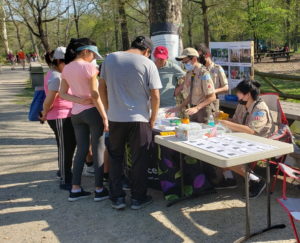 In June 2022, I graduated from the Virginia Youth Conservation Leadership Institute (YCLI) and gave my presentation to the board of the Virginia Youth Conservation Leadership Institute (YCLI) and received my certificate via mail from Ms. Maura Christian, the YCLI Coordinator, Education & Training Coordinator-Virginia Association of Soil & Water Conservation Districts. In addition, Dr. Sara Holtz and Ms. Ashley Palmer, the Conservation Education Specialist, Northern Virginia Soil & Water Conservation District, referred me to publish my presentation at the 2022 Virtual Student Environmental Action Showcase (SEAS). For details of my YCLI project presentation, you can check it out at this web link: https://seas.live/2022-seas/student-projects/
In June 2022, I graduated from the Virginia Youth Conservation Leadership Institute (YCLI) and gave my presentation to the board of the Virginia Youth Conservation Leadership Institute (YCLI) and received my certificate via mail from Ms. Maura Christian, the YCLI Coordinator, Education & Training Coordinator-Virginia Association of Soil & Water Conservation Districts. In addition, Dr. Sara Holtz and Ms. Ashley Palmer, the Conservation Education Specialist, Northern Virginia Soil & Water Conservation District, referred me to publish my presentation at the 2022 Virtual Student Environmental Action Showcase (SEAS). For details of my YCLI project presentation, you can check it out at this web link: https://seas.live/2022-seas/student-projects/

